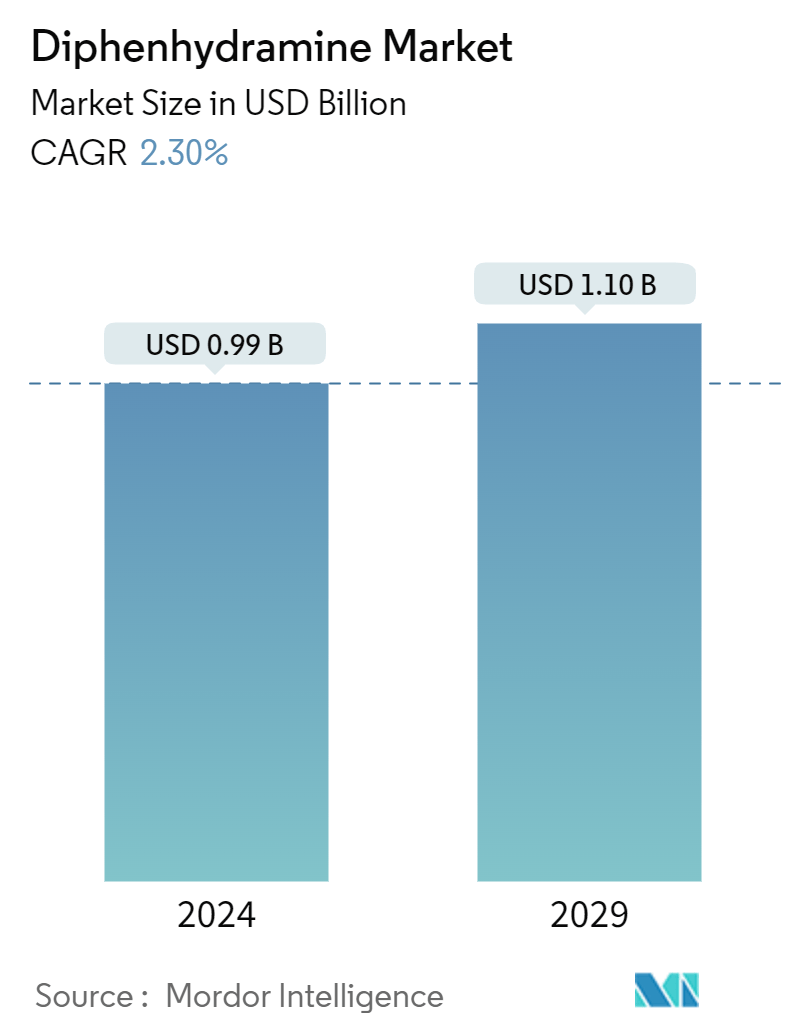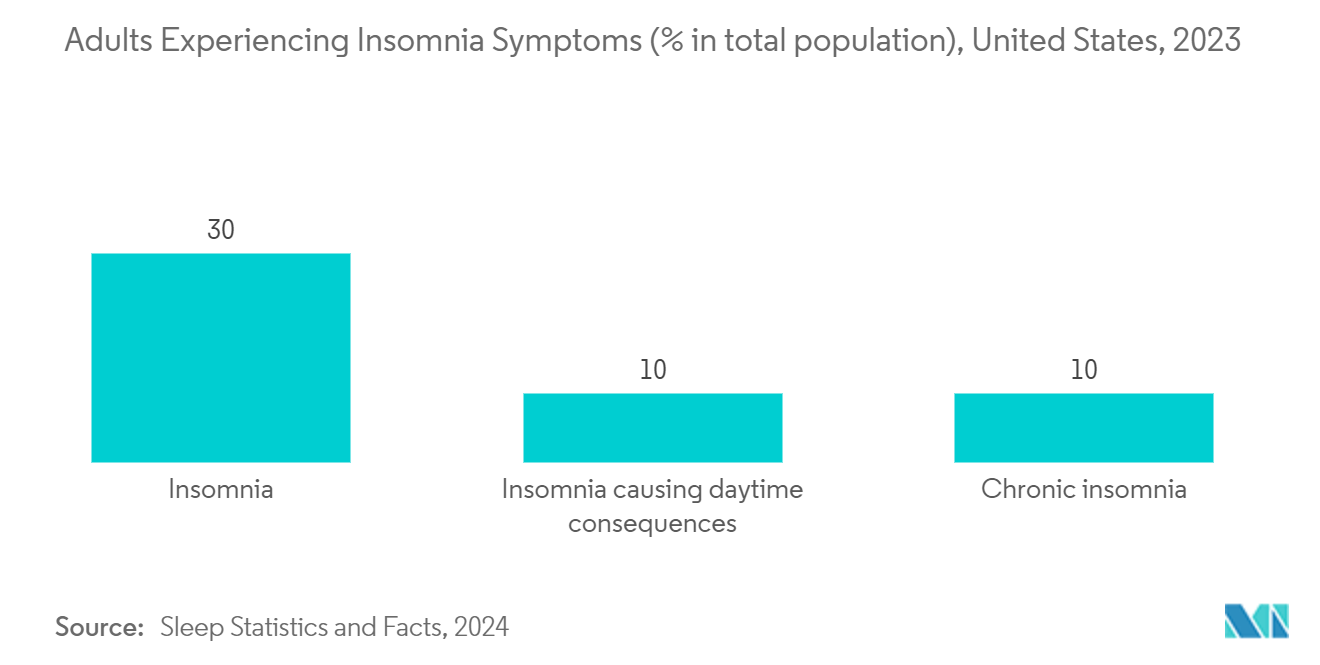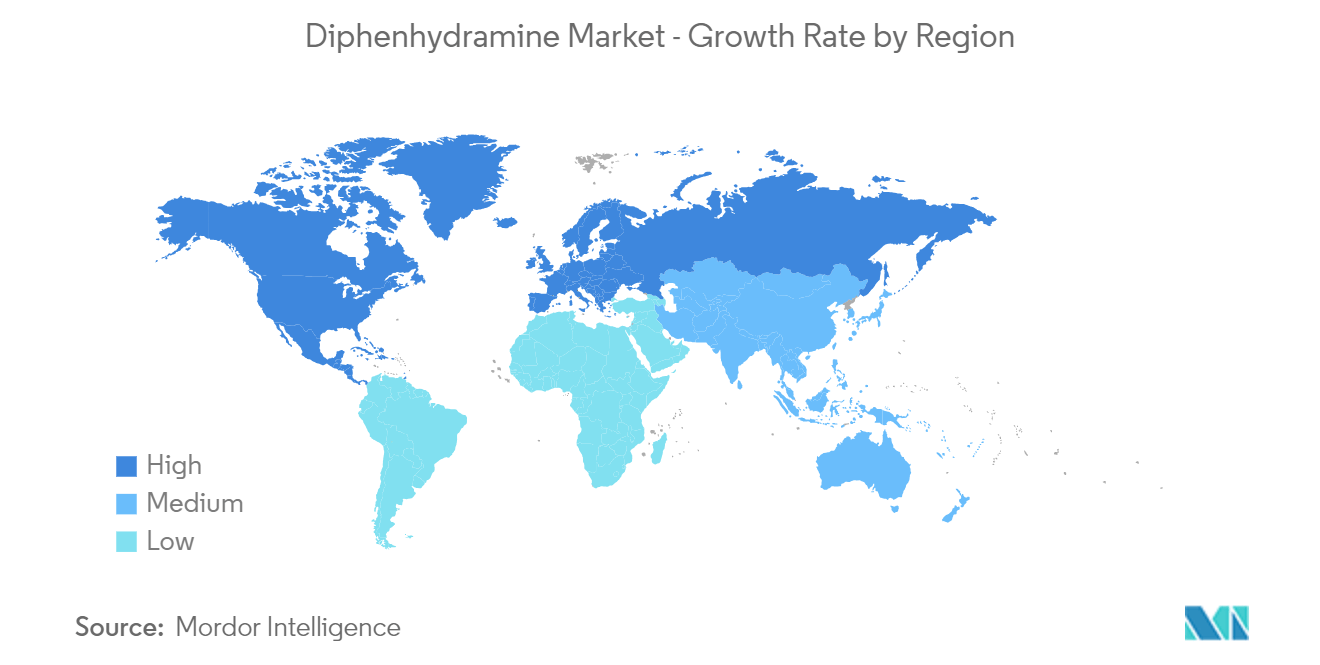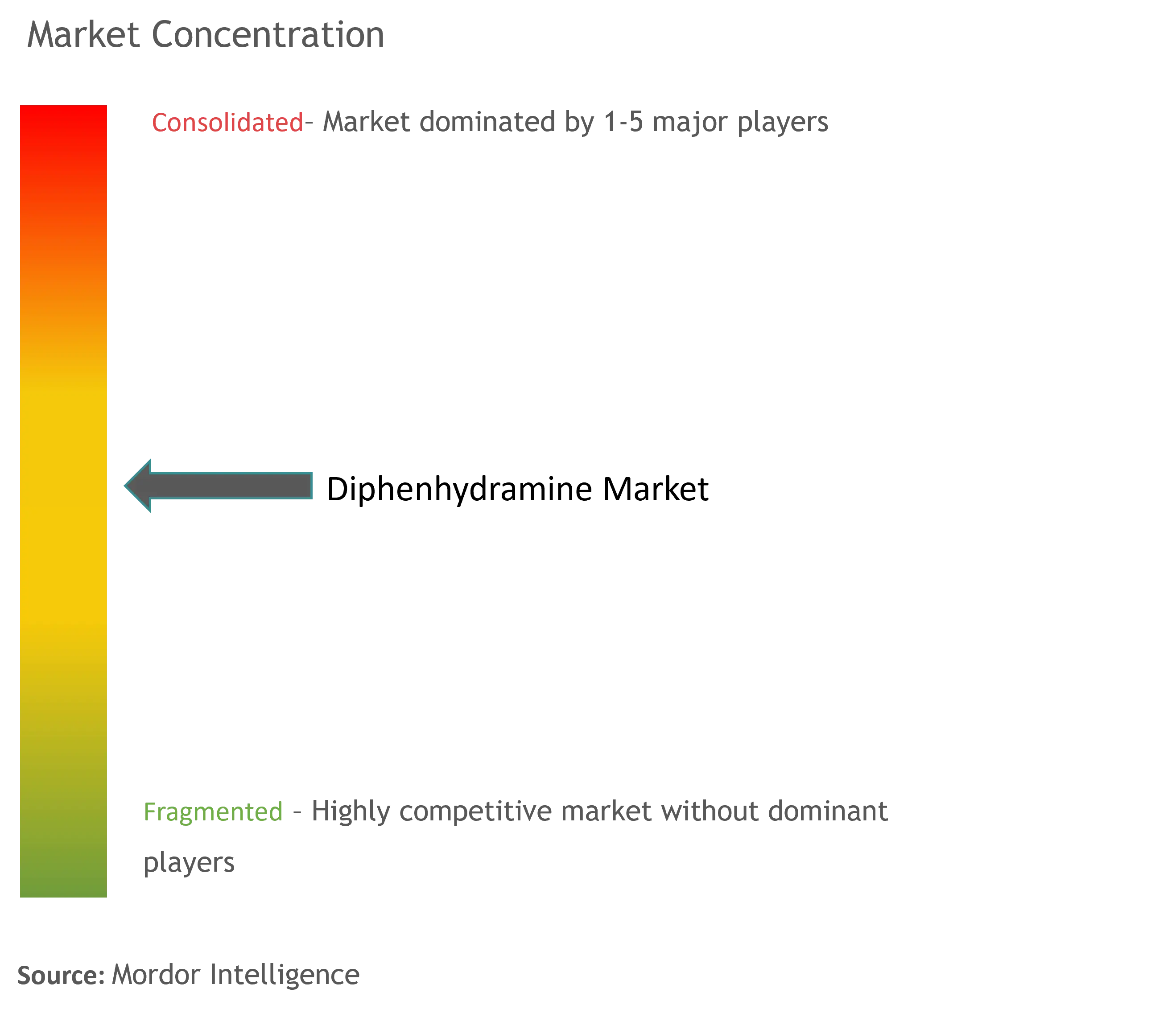Diphenhydramine Market Size

| Study Period | 2019 - 2029 |
| Market Size (2024) | USD 0.99 Billion |
| Market Size (2029) | USD 1.10 Billion |
| CAGR (2024 - 2029) | 2.30 % |
| Fastest Growing Market | Asia-Pacific |
| Largest Market | North America |
Major Players
*Disclaimer: Major Players sorted in no particular order |
Diphenhydramine Market Analysis
The Diphenhydramine Market size is estimated at USD 0.99 billion in 2024, and is expected to reach USD 1.10 billion by 2029, growing at a CAGR of 2.30% during the forecast period (2024-2029).
Factors such as the growing number of allergic populations, the rising prevalence of motion sickness and insomnia, and increasing research and development expenditures are expected to boost the market’s growth during the forecast period.
The rising number of people suffering from seasonal allergies is expected to increase the demand for effective medications that help reduce allergic symptoms, which is anticipated to fuel the growth of the market studied during the forecast period. For instance, according to the data published by the Centers for Disease Control and Prevention, in January 2023, approximately 25.7% of US adults reported experiencing seasonal allergies in 2022.
Similarly, as per an article published by the UK government in May 2024, about 50% of Europe's population is expected to suffer from some type of allergy sensitivity or aversion due to climate change by 2025. Thus, the expected increase in the number of people suffering from allergies is anticipated to bolster the demand for diphenhydramine, propelling the market’s growth.
The high burden of allergic rhinitis (AR) among the population is creating a huge burden on the healthcare system as well as impacting the quality of life. For instance, according to an article published in the World Allergy Organizational Journal in March 2024, allergic rhinitis affects approximately 10% to 40% of the global population, with a rising prevalence trend annually. Additionally, a study conducted to determine the prevalence of allergic rhinitis among children in Iran was published in Medi Media in May 2024; it was reported that the prevalence of allergic rhinitis surged from 5% at age 4 to a significant 14% by age 8. Thus, the increasing prevalence of allergic rhinitis raises the need for diphenhydramine in combination with other analgesics or sympathomimetic agents for combined relief of symptoms of allergic rhinitis. This is anticipated to bolster the market’s growth during the forecast period.
Furthermore, the growing prevalence of cold and flu cases globally is also expected to boost the growth of the diphenhydramine market. For instance, according to data published by the Centers for Disease Control and Prevention, in June 2024, about 35 to 64 million flu cases were reported in the United States, with 16 to 30 million medical visits from October 2024 to June 2024. Thus, the expected increase in flu cases raises the demand for medications that relieve symptoms such as runny nose, sneezing, and watery eyes, including diphenhydramine, and the availability of diphenhydramine as an OTC medication makes it accessible without the need for a prescription, boosting sales.
Therefore, owing to the aforementioned factors, such as the high burden of seasonal allergies and allergic rhinitis, the market studied is anticipated to grow during the forecast period. However, the side effects of diphenhydramine are likely to hinder the growth of the diphenhydramine market during the forecast period.
Diphenhydramine Market Trends
Insomnia Segment is Estimated to Witness Significant Growth During the Forecast Period
- Diphenhydramine is used to treat insomnia due to its sedative effects. It is available as an over-the-counter sleep aid formulation as it can induce drowsiness and help people fall asleep. The insomnia segment is expected to witness significant growth in the market owing to the growing numbers of individuals experiencing insomnia due to stress and lifestyle changes, the rising aging population, and the growing demand for diphenhydramine for treating sleep disorders.
- The rising stress levels and mental health conditions like anxiety and depression contribute to higher rates of insomnia, boosting the need for treatments like diphenhydramine. In addition, older adults are more prone to sleep disorders, which is expected to boost the demand for diphenhydramine during the forecast period. For instance, according to 2024 data published in the Mental Health Statistics report, about 37.1% of women and 29.9% of men in the United Kingdom reported high anxiety during 2022-2023. The 2022 data published by the National Health Service reported a rise in the number of individuals with insomnia in England, from 7.87 million in 2021 to 8.32 million in 2022. The high number of populations suffering from anxiety leads to insomnia, which, in turn, is anticipated to bolster the demand for drugs that induce sleep, thereby contributing to segment growth.
- The high prevalence of insomnia among the population is the key factor driving the demand for diphenhydramine to reduce sleep disorders; hence, it is anticipated to augment the segment’s growth. For instance, according to Sleep Statistics and Trends' May 2024 report, approximately 50% of insomnia cases in the United States arise from anxiety, depression, or psychological stress. Moreover, 30% of American adults experience insomnia, with one in ten enduring chronic insomnia nightly.
- Similarly, as per an article published by Sleep Journal, in April 2024, about 123 million adults (16.8%) in the Americas were affected by insomnia disorder, comprising 73 million females (19.5%) and 50 million males (14.0%). Thus, the high prevalence of insomnia among the population and the demand for antihistamine drugs for sedating effects are anticipated to propel the market’s growth during the forecast period.
- Furthermore, an article published by the Journal of Activity, Sedentary, and Sleep Behaviors in February 2024 highlighted insomnia as a significant health concern for older adults and is associated with a heightened morbidity rate and a decline in quality of life if left untreated. In addition, low education, chronic health conditions, smoking, being underweight, physical inactivity, and lack of exposure are some of the factors that are associated with the development of insomnia among the population.
- Therefore, owing to the high prevalence of insomnia owing to increasing stress, anxiety, and depression among the population, the segment is anticipated to grow during the forecast period.

North America is Expected to Have a Significant Market Share During the Forecast Period
- North America is anticipated to hold a significant share of the market during the forecast period owing to factors such as the increasing number of allergic people and growing government initiatives. For instance, according to the 2022 report from the Asthma and Allergy Foundation of America, around 25 metropolitan areas are under the high-risk category for allergy attacks.
- Additionally, motion sickness is becoming more common among international travelers, which is driving the need for motion sickness medications. For instance, according to the 2023 data published by the National Travel and Tourism Office, an estimated 66.5 million tourists traveled internationally in the United States in 2023, an increase of 31% compared to 2022. Thus, the increasing number of people traveling across countries increases the risk of experiencing motion sickness, which, in turn, is expected to increase the demand for effective drugs that reduce the symptoms. This is further expected to fuel the demand for diphenhydramine to prevent and treat nausea, vomiting, and dizziness caused by motion sickness, hence propelling the market’s growth.
- Furthermore, the high burden of insomnia among the population is expected to fuel market growth in North America during the forecast period. For instance, as per the Canadian Community Health Sleep Research Survey, in May 2022, more than 35% of Canadians found issues in falling asleep and staying asleep every night. Moreover, according to Sleep Statistics, updated in December 2022, between 10% and 30% of US adults struggle with chronic insomnia. Similarly, as per the Global Insomnia Statistics 2023 report, it was observed that half of the adults living in the United States experienced insomnia once a month or more in 2022. Thus, the high burden of the condition is expected to increase demand for novel antihistamine drugs, such as diphenhydramine, which cause drowsiness and induce sleep, which is anticipated to augment the market’s growth during the forecast period.
- Moreover, with the rising pollution levels and changing environmental conditions, there has been an increase in the prevalence of allergies. This trend is propelling the demand for antihistamines, such as diphenhydramine, in the market. For instance, the data published by the Clean Air Fund in May 2024 stated that approximately 131 million Americans were exposed to unhealthy levels of ozone and particle pollution in 2024, marking an increase of 11.7 million from 2023. Hence, increased public awareness of allergy symptoms, coupled with the availability of effective over-the-counter treatments like diphenhydramine, is driving more consumers to purchase diphenhydramine, which is expected to bolster market growth during the forecast period.
- Therefore, owing to the aforementioned factors, such as the high burden of insomnia, allergies, and motion sickness among the population, the market studied is anticipated to witness significant growth during the forecast period.

Diphenhydramine Industry Overview
The diphenhydramine market is moderately competitive and consists of several major players. The players are adopting key strategic activities such as collaborations, partnerships, and new product launches to retain market position. Some of the key companies in the market are PAI Pharma, Souvin Pharmaceuticals Pvt. Ltd, Pfizer Inc., Johnson & Johnson, and Fresenius Kabi.
Diphenhydramine Market Leaders
-
Fresenius Kabi
-
Johnson & Johnson
-
PAI Pharma
-
Pfizer Inc.
-
Souvin Pharmaceuticals Pvt.Ltd
*Disclaimer: Major Players sorted in no particular order

Diphenhydramine Market News
- May 2024: Stanford University, in collaboration with the National Institutes of Health (NIH), conducted a Phase II clinical study to examine the effect of diphenhydramine on sleep in children and adolescents with autism spectrum disorder (ASD)
- February 2023: Overseas Pharmaceuticals Ltd, in collaboration with Guangzhou Kangqi Medical Technology Co. Ltd, conducted a Phase I study to compare ibuprofen and diphenhydramine hydrochloride modified-release tablets among Chinese patients suffering from insomnia.
Diphenhydramine Market Report - Table of Contents
1. INTRODUCTION
- 1.1 Study Assumption and Market Definition
- 1.2 Scope of the Study
2. RESEARCH METHODOLOGY
3. EXECUTIVE SUMMARY
4. MARKET DYNAMICS
- 4.1 Market Overview
-
4.2 Market Drivers
- 4.2.1 Growing Number of Allergic Population
- 4.2.2 Rising Prevalence of MotionSsickness and Insomnia
- 4.2.3 Increasing Research and Development Expenditure
-
4.3 Market Restraints
- 4.3.1 Side Effects of Diphenhydramine
-
4.4 Porter's Five Forces Analysis
- 4.4.1 Threat of New Entrants
- 4.4.2 Bargaining Power of Buyers/Consumers
- 4.4.3 Bargaining Power of Suppliers
- 4.4.4 Threat of Substitute Products
- 4.4.5 Intensity of Competitive Rivalry
5. MARKET SEGMENTATION (Market Size by Value - USD)
-
5.1 By Dosage Forms
- 5.1.1 Tablets
- 5.1.2 Injection
- 5.1.3 Powder
- 5.1.4 Syrups
-
5.2 By Application
- 5.2.1 Allergies
- 5.2.2 Insomnia
- 5.2.3 Cold
- 5.2.4 Nausea
- 5.2.5 Other Applications
-
5.3 By Geography
- 5.3.1 North America
- 5.3.1.1 United States
- 5.3.1.2 Canada
- 5.3.1.3 Mexico
- 5.3.2 Europe
- 5.3.2.1 Germany
- 5.3.2.2 United Kingdom
- 5.3.2.3 France
- 5.3.2.4 Italy
- 5.3.2.5 Spain
- 5.3.2.6 Rest of Europe
- 5.3.3 Asia-Pacific
- 5.3.3.1 China
- 5.3.3.2 Japan
- 5.3.3.3 India
- 5.3.3.4 Australia
- 5.3.3.5 South Korea
- 5.3.3.6 Rest of Asia-Pacific
- 5.3.4 Middle East and Africa
- 5.3.4.1 GCC
- 5.3.4.2 South Africa
- 5.3.4.3 Rest of Middle East and Africa
- 5.3.5 South America
- 5.3.5.1 Brazil
- 5.3.5.2 Argentina
- 5.3.5.3 Rest of South America
6. COMPETITIVE LANDSCAPE
-
6.1 Company Profiles
- 6.1.1 Fresenius Kabi
- 6.1.2 Atom Pharma
- 6.1.3 PAI Pharma
- 6.1.4 Bayer Healthcare
- 6.1.5 Pfizer Inc.
- 6.1.6 Johnson & Johnson
- 6.1.7 S.S.Pharmachem
- 6.1.8 Remedy Labs
- 6.1.9 Amar Healthcare
- 6.1.10 Wan Bury Limited
- *List Not Exhaustive
7. MARKET OPPORTUNITIES AND FUTURE TRENDS
** Subject To AvailablityDiphenhydramine Industry Segmentation
As per the scope of the report, diphenhydramine is an antihistamine used to treat allergies, hay fever, and colds. It reduces the effect of the natural chemical histamine in the body. It is also used to prevent nausea, vomiting, and motion sickness.
The diphenhydramine market is segmented by dosage forms, application, and geography. By dosage form, the market is segmented into tablets, injections, powders, and syrups. By application, the market is bifurcated into allergies, insomnia, colds, nausea, and other applications. By geography, the market is divided into North America, Europe, Asia-Pacific, Middle East and Africa, and South America. The report offers the value (USD) for the above segments.
| By Dosage Forms | Tablets | |
| Injection | ||
| Powder | ||
| Syrups | ||
| By Application | Allergies | |
| Insomnia | ||
| Cold | ||
| Nausea | ||
| Other Applications | ||
| By Geography | North America | United States |
| Canada | ||
| Mexico | ||
| By Geography | Europe | Germany |
| United Kingdom | ||
| France | ||
| Italy | ||
| Spain | ||
| Rest of Europe | ||
| By Geography | Asia-Pacific | China |
| Japan | ||
| India | ||
| Australia | ||
| South Korea | ||
| Rest of Asia-Pacific | ||
| By Geography | Middle East and Africa | GCC |
| South Africa | ||
| Rest of Middle East and Africa | ||
| By Geography | South America | Brazil |
| Argentina | ||
| Rest of South America |
Diphenhydramine Market Research FAQs
How big is the Diphenhydramine Market?
The Diphenhydramine Market size is expected to reach USD 0.99 billion in 2024 and grow at a CAGR of 2.30% to reach USD 1.10 billion by 2029.
What is the current Diphenhydramine Market size?
In 2024, the Diphenhydramine Market size is expected to reach USD 0.99 billion.
Who are the key players in Diphenhydramine Market?
Fresenius Kabi, Johnson & Johnson, PAI Pharma, Pfizer Inc. and Souvin Pharmaceuticals Pvt.Ltd are the major companies operating in the Diphenhydramine Market.
Which is the fastest growing region in Diphenhydramine Market?
Asia-Pacific is estimated to grow at the highest CAGR over the forecast period (2024-2029).
Which region has the biggest share in Diphenhydramine Market?
In 2024, the North America accounts for the largest market share in Diphenhydramine Market.
What years does this Diphenhydramine Market cover, and what was the market size in 2023?
In 2023, the Diphenhydramine Market size was estimated at USD 0.97 billion. The report covers the Diphenhydramine Market historical market size for years: 2019, 2020, 2021, 2022 and 2023. The report also forecasts the Diphenhydramine Market size for years: 2024, 2025, 2026, 2027, 2028 and 2029.
Antihistamine Drugs Industry Report
Statistics for the 2024 Antihistamine Drugs market share, size and revenue growth rate, created by Mordor Intelligence™ Industry Reports. Antihistamine Drugs analysis includes a market forecast outlook to 2029 and historical overview. Get a sample of this industry analysis as a free report PDF download.



